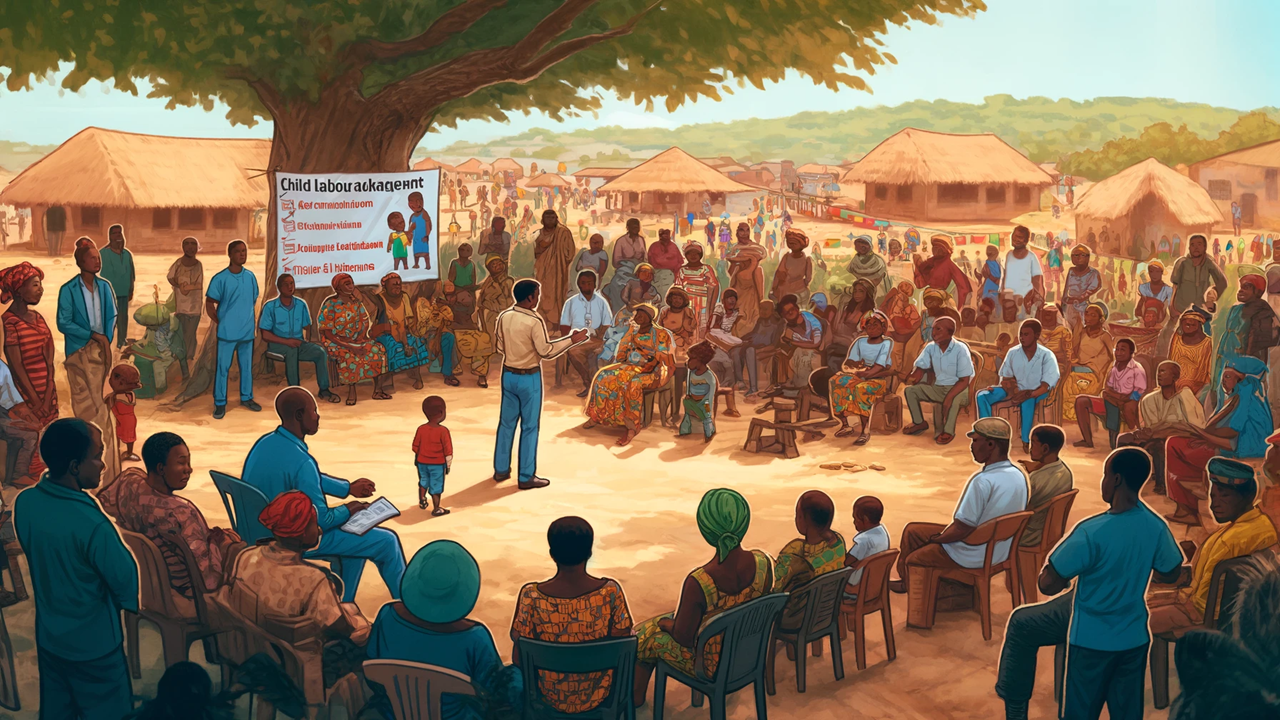Safeguarding Ghana's Future: Tackling Child Labor Through Strategic Project Management
A comprehensive World Bank report unveils a new systematic approach to managing child labor risks in Ghana's project portfolio. Developed by the Social Sustainability and Inclusion (SSI) team, the initiative spans 2021-2023 and aims to integrate child labor risk management into project cycles. Despite Ghana's robust legal framework, the incidence of child labor remains high. The report highlights the cultural and socio-economic factors contributing to this issue and outlines a detailed risk management toolkit to mitigate these risks.

In a bid to address the persistent issue of child labor in Ghana, the World Bank has unveiled a groundbreaking approach to managing child labor risks across its project portfolio. The initiative, spearheaded by the Social Sustainability and Inclusion (SSI) team of the Ghana Country Management Unit (CMU), aims to integrate comprehensive risk management strategies into the lifecycle of various projects. Spanning from 2021 to 2023, this systematic approach represents a significant step towards safeguarding the future of Ghana's children.
The Scope and Objectives
The initiative was born out of a portfolio-wide risk mitigation assessment that identified critical areas requiring improvement in managing child labor risks. To address these gaps, the SSI team developed a detailed toolkit designed to guide teams and Project Implementation Units (PIUs) in systematically managing child labor risks. The toolkit's creation was a collaborative effort, incorporating feedback from World Bank managers and professionals, and undergoing peer review in 2022.
Training has been a crucial component of this initiative. Throughout 2022 and 2023, a series of training sessions were conducted for PIUs in Ghana. These sessions aimed to equip project teams with the necessary skills and knowledge to effectively manage child labor risks. The initiative's progress and outcomes were also shared through bank-wide dissemination meetings and additional trainings, ensuring that best practices are adopted across all relevant projects.
Understanding the Context of Child Labor in Ghana
Despite having a robust legal framework to address child labor, Ghana continues to grapple with high incidence rates. According to estimates, 27.9% of children aged 5 to 17 are engaged in child labor, with a staggering 74% of these children involved in hazardous work. These statistics underscore the urgent need for targeted interventions to protect the nation's youth.
Cultural and socio-economic factors play a significant role in perpetuating child labor in Ghana. Many families, particularly in rural areas, rely on their children's labor for economic survival. This reliance is deeply rooted in cultural norms that accept child labor as a necessary part of life. Additionally, Ghana faces significant challenges with child trafficking, with many children trafficked for exploitation in various sectors, further complicating efforts to eradicate child labor.
The Underlying Causes and Impacts of Child Labor
The root causes of child labor are multifaceted, encompassing community and societal norms, economic pressures, and systemic issues within the labor market. In many communities, there is a lack of awareness about the harmful effects of child labor. This ignorance, combined with the economic necessity for cheap labor, fuels the demand for child workers. Weak enforcement of labor laws exacerbates the problem, allowing child labor to persist unchecked.
The socio-economic impact of child labor is profound. Children engaged in labor miss out on educational opportunities, affecting their future prospects and perpetuating cycles of poverty. The physical and mental toll of hazardous work conditions further impairs their development, leading to long-term health issues and reduced economic productivity.
The Pilot Project for Child Labor Risk Management
The World Bank's pilot project focuses on sectors particularly prone to child labor, including agriculture, cocoa, forestry, fishing, and mining. By integrating child labor risk management into environmental and social risk assessments for these projects, the initiative aims to create a holistic approach to mitigating these risks.
The toolkit developed for this project is comprehensive, providing step-by-step guidance for identifying, mitigating, and managing child labor risks. It includes screening tools to assess the risk level of each project during the identification stage, as well as tailored strategies for managing and reducing these risks based on the assessed levels. Additionally, the toolkit outlines guidelines for implementing risk management techniques and continuously monitoring their effectiveness throughout the project lifecycle.
Key Strategies and Policy Recommendations
To effectively combat child labor, the report outlines several key strategies and policy recommendations:
-
Sector-Specific Reforms:
- Initiating sector modernization and reforms to reduce manual labor and hazardous work conditions.
- Supporting human development projects that provide education, health, and social protection to mitigate child labor risks.
-
Workplace Management:
- Implementing Labor Management Procedures (LMPs) to ensure safe working conditions for children within legal age limits.
- Enforcing age verification, health and safety policies, and supervision plans in workplaces.
-
Capacity Strengthening:
- Enhancing national systems' capacity for preventing, identifying, and remediating child labor.
- Collaborating with stakeholders for comprehensive interventions in high-risk areas.
These strategies are designed to address both the immediate and underlying causes of child labor, ensuring a sustainable approach to risk management. By focusing on sector-specific reforms, workplace management, and capacity strengthening, the initiative aims to create a safer, more supportive environment for Ghana's children.
Conclusion and Future Directions
The World Bank's approach to managing child labor risks in Ghana's project portfolio represents a significant advancement in safeguarding the nation's youth. By integrating child labor prevention into project cycles and leveraging human development projects, the initiative addresses the root causes of child labor and promotes long-term solutions.
As the initiative progresses, continuous training and collaboration with stakeholders will be essential to its success. The ongoing efforts and future initiatives aim to create a safer, more supportive environment for children, ultimately contributing to the global goal of eliminating child labor by 2025. By addressing the cultural, socio-economic, and systemic factors that perpetuate child labor, Ghana can pave the way for a brighter future for its youngest citizens.










